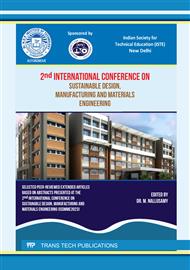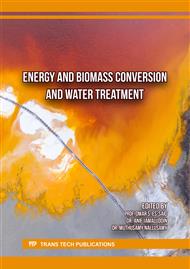[1]
T. R. Sreekrishnan, S. Kohli, and V. Rana, "Enhancement of biogas production from solid substrates using different techniques –– a review," vol. 95, p.1–10, 2004.
DOI: 10.1016/j.biortech.2004.02.010
Google Scholar
[2]
P. Weiland, "Biogas production: Current state and perspectives," Applied Microbiology and Biotechnology, vol. 85, no. 4, p.849–860, 2010.
DOI: 10.1007/s00253-009-2246-7
Google Scholar
[3]
J. H. Patil, M. A. L. AntonyRaj, B. B. Shankar, M. K. Shetty, and B. P. Pradeep Kumar, "Anaerobic co-digestion of Water Hyacinth and Sheep Waste," Energy Procedia, vol. 52, p.572–578, 2014.
DOI: 10.1016/j.egypro.2014.07.112
Google Scholar
[4]
K. Kumar, "Multi Objective Optimization of Anaerobic Digestion of Poultry Litter Using Taguchi Grey Relational Analysis," 2018. [Online]. Available: http://www.ripublication.com5216
Google Scholar
[5]
M. Baniasadi, A. Tugnoli, R. Conti, C. Torri, D. Fabbri, and V. Cozzani, "Waste to energy valorization of poultry litter by slow pyrolysis," Renewable Energy, vol. 90, p.458–468, 2016.
DOI: 10.1016/j.renene.2016.01.018
Google Scholar
[6]
T. Rehl and J. Müller, "Life cycle assessment of biogas digestate processing technologies," Resources, Conservation and Recycling, vol. 56, no. 1, p.92–104, 2011.
DOI: 10.1016/j.resconrec.2011.08.007
Google Scholar
[7]
A. Malik, "Environmental challenge vis a vis opportunity: The case of water hyacinth," Environment International, vol. 33, no. 1, p.122–138, 2007.
DOI: 10.1016/j.envint.2006.08.004
Google Scholar
[8]
S. Rezania, M. Ponraj, M. F. M. Din, A. R. Songip, F. M. Sairan, and S. Chelliapan, "The diverse applications of water hyacinth with main focus on sustainable energy and production for new era: An overview," Renewable and Sustainable Energy Reviews, vol. 41, p.943–954, 2015.
DOI: 10.1016/j.rser.2014.09.006
Google Scholar
[9]
J. Cheng, B. Xie, J. Zhou, W. Song, and K. Cen, "Cogeneration of H2 and CH4 from water hyacinth by two-step anaerobic fermentation," International Journal of Hydrogen Energy, vol. 35, no. 7, p.3029–3035, 2010.
DOI: 10.1016/j.ijhydene.2009.07.012
Google Scholar
[10]
R. Sindhu et al., "Water hyacinth a potential source for value addition: An overview," Bioresource Technology, vol. 230, p.152–162, 2017.
DOI: 10.1016/j.biortech.2017.01.035
Google Scholar
[11]
C. C. Gunnarsson and C. M. Petersen, "Water hyacinths as a resource in agriculture and energy production: A literature review," Waste Management, vol. 27, no. 1, p.117–129, 2007.
DOI: 10.1016/j.wasman.2005.12.011
Google Scholar
[12]
J. B. Holm-Nielsen, T. Al Seadi, and P. Oleskowicz-Popiel, "The future of anaerobic digestion and biogas utilization," Bioresource Technology, vol. 100, no. 22, p.5478–5484, 2009.
DOI: 10.1016/j.biortech.2008.12.046
Google Scholar
[13]
J. Bacenetti, M. Negri, M. Fiala, and S. González-García, "Anaerobic digestion of different feedstocks: Impact on energetic and environmental balances of biogas process," Science of the Total Environment, vol. 463–464, p.541–551, 2013.
DOI: 10.1016/j.scitotenv.2013.06.058
Google Scholar
[14]
J. Ariunbaatar, A. Panico, G. Esposito, F. Pirozzi, and P. N. L. Lens, "Pretreatment methods to enhance anaerobic digestion of organic solid waste," APPLIED ENERGY, vol. 123, p.143–156, 2014.
DOI: 10.1016/j.apenergy.2014.02.035
Google Scholar
[15]
M. J. Taherzadeh and K. Karimi, Pretreatment of lignocellulosic wastes to improve ethanol and biogas production: A review, vol. 9, no. 9. 2008.
DOI: 10.3390/ijms9091621
Google Scholar
[16]
V. Patel, M. Desai, and D. Madamwar, "Thermochemical pretreatment of water hyacinth for improved biomethanation," Applied Biochemistry and Biotechnology, vol. 42, no. 1, p.67–74, 1993.
DOI: 10.1007/BF02788902
Google Scholar
[17]
B. Selvaraj et al., "Kinetic modelling of augmenting biomethane yield from poultry litter by mitigating ammonia," Int J Green Energy, vol. 15, no. 12, p.766–772, 2018.
DOI: 10.1080/15435075.2018.1529580
Google Scholar
[18]
Y. Zheng, J. Zhao, F. Xu, and Y. Li, "Pretreatment of lignocellulosic biomass for enhanced biogas production," Progress in Energy and Combustion Science, vol. 42, no. 1, p.35–53, 2014.
DOI: 10.1016/j.pecs.2014.01.001
Google Scholar
[19]
A. Saboor, S. Khan, A. Ali Shah, F. Hasan, H. Khan, and M. Badshah, "Enhancement of biomethane production from cattle manure with codigestion of dilute acid pretreated lignocellulosic biomass," International Journal of Green Energy, vol. 14, no. 7, p.632–637, 2017.
DOI: 10.1080/15435075.2017.1313740
Google Scholar
[20]
J. H. Patil, M. Antonyraj, C. C. Gavimath, and V. R. Hooli, "a Comperative Study on Anaerobic Co-Digestion of Water Hyacinth With Poultry Litter and Cow Dung," vol. 2, no. 2, p.148–155, 2011.
Google Scholar
[21]
K. A. Adeniran, I. E. Ahaneku, I. N. Itodo, and H. A. Rohjy, "Relative effectiveness of biogas production using poultry wastes and cow dung," vol. 16, no. 1, p.126–132, 2014.
Google Scholar
[22]
M. Of, N. In, T. H. E. Poultry, L. To, and E. Biomethane, "mitigation of nitrogen in the poultry litter to enhance biomethane production Balaji.S".
Google Scholar



